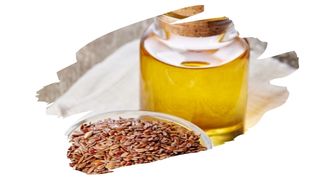What’s one of the most popular oil finishes out there right now? Tru-oil.
It’s popularly used as a way to add a high gloss shine on everything from guitars to furniture. And this quick-drying finish is super easy to apply with even a rag, all thanks to its thinner consistency.
After it is dry, the finish Tru-oil leaves behind is a fantastic almost glass-like gloss on wood. And the reason it is able to do all of this, in no small part, boils down to its Linseed oil ingredient.
Made from a blend of Linseed oil (and sometimes Tung oil), Varnish, and Mineral Paint Thinners, Tru-oil brings with it many of the benefits of a Linseed oil finish… but without the waiting around time.
But, does Tru-oil really beat out pure (or boiled) Linseed oil as a wood finish?
Tru-oil dries in less than half the time of Linseed oil. And it doesn’t yellow with age, the way Linseed oil does either.
However, Linseed oil soaks further into wood than Tru-oil, better helping to protect it from decay (caused by moisture). Plus, due to its thicker consistency, Linseed oil needs fewer application coats than Tru-oil.
But, the key difference between the two lies more in the condition of the wood you will be coating them onto.
Linseed is better on bare wood. It works best by penetrating wood pores, leaving very little film resin on the surface (once you’ve wiped away the excess).
But what if those wood pores are already filled with a previous oil finish?
In which case, Tru-oil is a better choice when it comes to refinishing wood. Once you’ve stripped off the original finish, Tru-oil will protect that wood by mostly building up film on the surface. It will still penetrate the timber, just simply not as deep as a Linseed oil finish would.
Still puzzled as to which oil finish to use on your woodwork piece? Well, keep reading to get the answers to the top 5 questions we always get about these two popular oil finishes…

This post may contain affiliate links to products that we receive a commission for (at no additional cost to you). Learn more here.
Your Top 5 Tru-oil Questions
1). Is Tru-oil Pretty Much The Same As Linseed Oil?
Tru-oil is very different from Pure Linseed Oil. Mainly due to the fact that Linseed oil is a natural finish, and Tru-oil is not.
Made from flaxseeds, pure Linseed oil has been used as a key ingredient in making moisture resistant stains, paints and finishes.
Boiled linseed oil differs from Tru-oil too. That is because boiled linseed oil, (also referred to as BLO), is created when pure linseed oil is put through a superheated chemical treatment. This treatment process drastically reduces the drying time of pure linseed oil.
2). What Is Tru-oil Made Out Of?
Tru-oil is a blend of Linseed/Tung oil, varnish and paint thinner.
In other words, Linseed oil is one of many ingredients that can be found in Tru-oil. But Linseed oil and Tru-oil are not one and the same.
Related Post: The Top 3 Tru-oil Alternatives That’ll Give Your Guitar A Fine Finish
3). Is Tru-oil Flammable (Just Like Linseed Oil)?
One of the first things you should know about Linseed oil is that it doesn’t take much to set off this substance.
In fact, you don’t even need a spark for this oil-based finish to spontaneously go up in flame.
This high combustibility factor comes about due to Linseed oil reacting with oxygen molecules in the air. Which is why you always need to be careful when disposing of Linseed oil soaked rags (even if they’re dry).
Now, Tru-oil is just as flammable as Linseed oil – for much the same reason. So you should apply the same safety precautions when disposing of rags that have been soaked in Tru-oil. Safety precautions such as;
- Don’t bunch up multiple rags together.
- Lay them out separately so that they can dry slowly.
- And don’t reuse or store them. Simply wait for them to become bone-dry, and then throw them out.
4). Is Tru-oil Weather Resistant?
It’s moisture-resistant, not weather resistant.
In other words, it can shrug off a bit of humidity – and help prevent wood rot and decay.
But it won’t protect wood from a deluge of rain water – or high humidity environments.
Related Post: What You Need To Know About Danish Oil vs Tru Oil
5). And Does Tru-oil Dry Into A Hard Film?
A hard film? No. But does Tru-oil cure into a stiff, rigid film? Yes, it does.
That’s because Tru-oil isn’t very scratch resistant or durable. So if you are looking for something that can handle a lot of dings and dents, this is not the wood finish for you.
Tru-oil is just too thin a substance to really leave behind a thick hard resin.
If you want a finish that’ll give your guitar more protection, then you need to check out polyurethane. This fast drying sealer is scratch-resistant, and waterproof. Learn more by clicking over to our article: When Should You Use Tru-oil Vs Wipe-On Poly? [3 Key Comparisons]

Your Top 5 Linseed Oil Questions
1). What Is Linseed Oil Best Used For?
It’s used in everything from paints, to stains, to finishes. But, at its core, it is best used as a way to help prevent wood decay and rot from setting into wood.
By soaking into and throughout wood, it manages to coat those wood fibers in a lubricant that cures into a resin that keeps moisture out.
2). So, Is Linseed Oil A Good Wood Finish?
It is a great finish, provided that you use it for what it is intended for… and that is to add waterproofing to lumber.
It is not, however, completely waterproof. Which means it will more often than not require at least some kind of top coat sealant to go over it.
Related Post: Can You Put Epoxy Over Linseed Oil (For A Longer Lasting Finish)?
3). How Long Does Linseed Oil Last On Wood?
It takes up to 3 days for Linseed oil to dry into a solid film. And it can take up to 10 weeks for it to cure into a hard resin.
Related Post: How To Make Linseed Oil Dry Faster (What You Need To Know)
And if you then apply a tough and durable sealer, (such as an oil-based polyurethane), over that Linseed oil finish, then it can last 5-10 years.
4). When Should I Use Linseed Oil On Wood?
This wood finish should only be used on bare wood that hasn’t been previously covered in any other penetrating stain or finish.
Linseed oil needs to soak to work. And anything that stops it from doing just that will prevent this finish from doing its job effectively.
5). Is Flaxseed Seriously The Same Thing As Linseed?
Raw Linseed oil is an oily substance that gets crushed out of Flaxseed.
The oil this plant produces is all natural, food safe, edible, and can even be used as a food supplement. And this raw and uncut version of Linseed oil takes forever to dry.
Okay, not quite forever, but it will certainly feel like it.
Important Note: Boiled Linseed oil is not at all fit to be consumed at all in any way shape or form. Although once it has completely and thoroughly cured, it does become food-safe enough to use as a finish on kitchen utensils.
References
Drying and oxidative degradation of linseed oil – ScienceDirect



